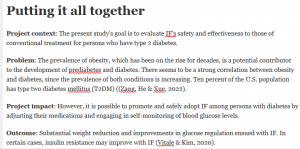Putting it all together

Project context: The present study’s goal is to evaluate IF’s safety and effectiveness to those of conventional treatment for persons who have type 2 diabetes.
Problem: The prevalence of obesity, which has been on the rise for decades, is a potential contributor to the development of prediabetes and diabetes. There seems to be a strong correlation between obesity and diabetes, since the prevalence of both conditions is increasing. Ten percent of the U.S. population has type two diabetes mellitus (T2DM) ((Zang, He & Xue, 2022).
Project impact: However, it is possible to promote and safely adopt IF among persons with diabetes by adjusting their medications and engaging in self-monitoring of blood glucose levels.
Outcome: Substantial weight reduction and improvements in glucose regulation ensued with IF. In certain cases, insulin resistance may improve with IF (Vitale & Kim, 2020).
Proposed solution: Managing glucose levels in individuals with type 2 diabetes using IF.
Correlation of Intermittent Fasting (IF) to Type Two Diabetes Mellitus T2DM
Factors influencing selected strategy:
1. Insulin resistance.
2. Poor dieting.
3. Failure to adhere to scheduled eating and fasting windows.
4. Inactive lifestyle.
Evidence base supported solution: Diabetic-related problems may be effectively treated and prevented with dietary modifications, as affirmed by both clinical practice and the majority of national diabetes organizations (Zang, He & Xue, 2022). Intermittent fasting is only one of numerous nutritional therapies that may be tried. A dietary intervention that shifts the length of the overnight fast from 12 to 18 or 20 hours may be useful as an additional dietary approach in the treatment of diabetes mellitus (Vitale & Kim, 2020).